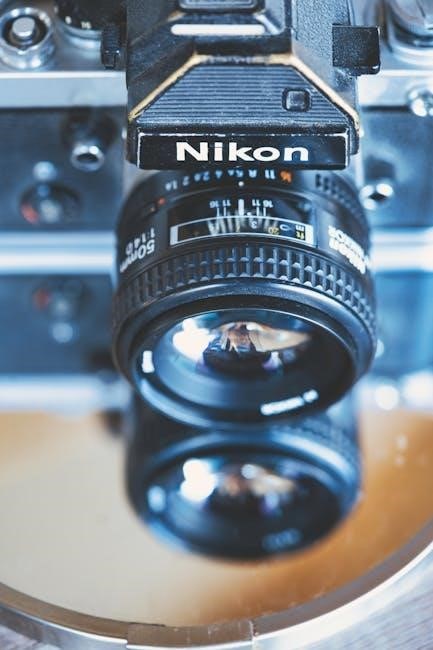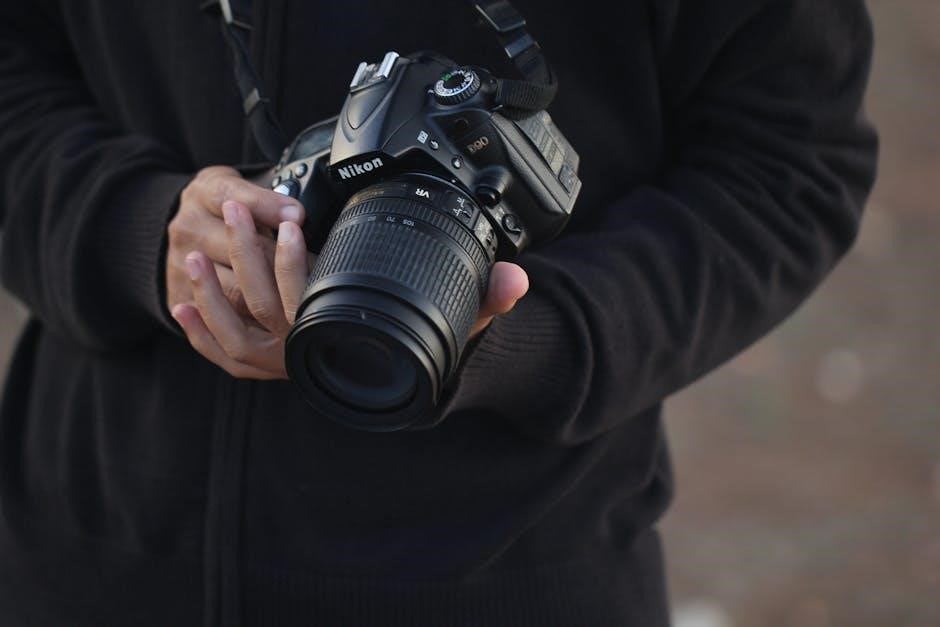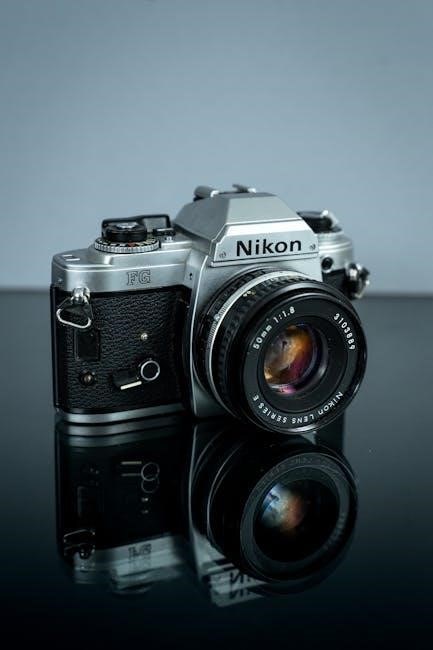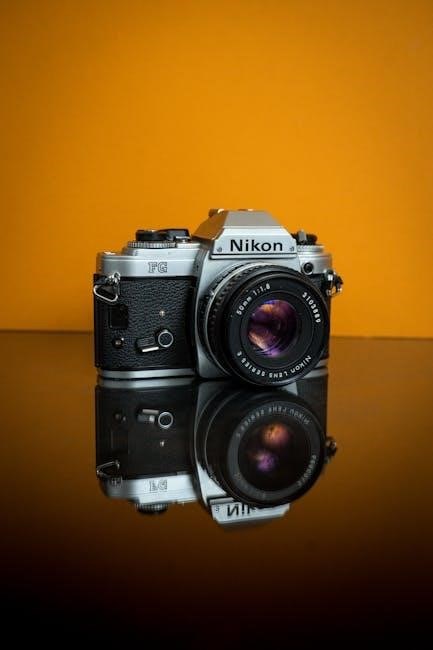Welcome to the Nikon EM manual, your comprehensive guide to mastering this iconic camera. Designed for both beginners and experienced photographers, this manual covers essential features, operation, and maintenance tips to enhance your photography experience.
1.1 Overview of the Nikon EM Camera
The Nikon EM is a compact and lightweight 35mm film SLR camera introduced in 1979. It features an aperture-priority automatic exposure mode, allowing users to select the aperture while the camera automatically adjusts the shutter speed. Designed for ease of use, the EM is compatible with a wide range of lenses, including Nikon Series E and AI-type Nikkor lenses. Its durable construction and intuitive controls make it suitable for both beginners and experienced photographers. The camera supports motorized shooting with the MD-E Motor Drive and flash photography using the SB-E Speedlight. With its portability and versatile features, the Nikon EM remains a popular choice for film photography enthusiasts. This section provides a foundational understanding of the camera’s design and capabilities.

1.2 Importance of the Manual for Optimal Camera Use
The Nikon EM manual is essential for unlocking the full potential of your camera. It provides detailed instructions on operating modes, lens compatibility, and maintenance tips, ensuring you get the best results. By understanding exposure modes, such as aperture-priority and manual, you can control lighting and depth effectively. The manual also guides you through mounting lenses, loading film, and using accessories like the MD-E Motor Drive and SB-E Speedlight. Proper care and troubleshooting tips are included to maintain your camera’s performance. Whether you’re a novice or an experienced photographer, the manual offers insights to enhance your shooting experience and troubleshooting common issues, making it an indispensable resource for mastering the Nikon EM.

Key Features of the Nikon EM
The Nikon EM features aperture-priority mode, manual controls, and compatibility with various Nikkor lenses and accessories, making it versatile for photographers of all skill levels.
2.1 Aperture-Priority Automatic Exposure
The Nikon EM offers an aperture-priority automatic exposure mode, allowing photographers to select the desired aperture while the camera automatically adjusts the shutter speed. This feature simplifies shooting in various lighting conditions, ensuring optimal exposure. Photographers can choose the aperture to control depth of field, with the camera handling the rest. The manual explains how to use this mode effectively for creative control and precise results, making it ideal for both beginners and advanced users seeking consistent exposures without manual calculations.
2.2 Manual Control Options
The Nikon EM provides manual control options for photographers who prefer precise control over their shots. In Manual Mode (M90 and B), users can set both aperture and shutter speed independently. The M90 mode locks the shutter speed at 1/90th of a second, while the B mode allows for extended exposures, controlled by the photographer. These manual settings enable creative freedom, especially in challenging lighting conditions or for specific artistic effects. The manual explains how to use these modes effectively, ensuring photographers can achieve their desired results with ease and precision.
2.3 Compatible Lenses and Accessories
The Nikon EM is compatible with a variety of lenses and accessories, enhancing its versatility for different photography needs. The camera supports Nikon Series E lenses, AI-type Nikkor lenses, and other compatible optics, ensuring a wide range of focal lengths and shooting styles. Additionally, accessories like the MD-E Motor Drive for motorized shooting and the SB-E Speedlight for flash photography expand the camera’s capabilities. These accessories integrate seamlessly with the EM, offering photographers the tools to experiment with advanced techniques and improve their results. The manual provides detailed information on compatible equipment, helping users make informed choices for their photography setup.

Basic Camera Operation
Mastering the Nikon EM begins with mounting the lens, loading film, and setting aperture and shutter speed. Use the shutter release button to capture your shots effortlessly.
3.1 Mounting the Lens
Mounting the lens on your Nikon EM is a straightforward process. First, ensure the camera body and lens are prepared. Remove the rear lens cap and align the lens mount with the camera’s mounting flange. Gently twist the lens clockwise until it securely clicks into place. Make sure it is properly seated to avoid any misalignment or damage. The Nikon EM is compatible with Nikon Series E and AI-type Nikkor lenses, among others, as detailed in the manual. Proper lens mounting ensures optimal performance and image quality. Always handle the lens with care to prevent scratches or damage to the mount. If unsure, refer to the manual for specific guidance on compatible lenses and mounting techniques. Proper alignment is crucial for maintaining the camera’s functionality and ensuring sharp, clear photos. Avoid forcing the lens, as this could damage the mount or the lens itself. By following these steps, you can safely and effectively mount your lens and start capturing stunning images with your Nikon EM.
3.2 Loading and Advancing Film
Loading film into the Nikon EM is a simple yet precise process. Open the camera back by pulling the release latch. Attach the film leader to the take-up spool, ensuring it is securely aligned. Advance the film by winding the lever until it stops, confirming the film is properly loaded. Close the camera back and press the shutter release to advance the film to the first frame. The frame counter will indicate the number of exposures; Always handle the film in a dark environment or use a changing bag to avoid exposure to light. After loading, advance the film before taking the first shot and after each exposure to ensure proper positioning. Proper film loading and advancing are essential for capturing sharp, clear images with your Nikon EM.
3.3 Setting the Aperture and Shutter Speed
Setting the aperture and shutter speed on the Nikon EM is straightforward. In Aperture-Priority mode, select your desired f-stop using the aperture ring on the lens. The camera will automatically set the appropriate shutter speed based on the metered light. For manual control, switch to M90 or B mode. In M90, the shutter speed is fixed at 1/90 second, while B mode allows for bulb exposures. Always ensure the lens is set to the correct aperture and that the shutter speed aligns with your creative vision. Proper adjustment of these settings is crucial for achieving optimal exposure and capturing the desired effect in your photographs. Use the built-in light meter as a guide to make precise adjustments for varying lighting conditions.
3.4 Using the Shutter Release Button
The shutter release button on the Nikon EM is designed for smooth and precise operation. To take a photo, press the button gently but firmly. For accurate metering, press the button halfway to activate the light meter and focus. Once focused, press the button fully to release the shutter. Ensure a steady hand to avoid camera shake, especially in low-light conditions. After taking a shot, use the film winding lever to advance the film to the next frame. Proper use of the shutter release button ensures sharp and well-timed photographs. Always check that the camera is properly set up before pressing the shutter to achieve the best results.

Exposure Modes and Settings
The Nikon EM offers Aperture-Priority (A) and Manual (M90, B) modes, providing control over exposure settings. It also supports flash photography with the SB-E Speedlight for enhanced lighting options.
4.1 Aperture-Priority Mode (A)
In Aperture-Priority mode (A), you select the desired aperture (f-stop), and the camera automatically sets the optimal shutter speed. This mode is ideal for controlling depth of field while ensuring correct exposure. The Nikon EM’s metering system accurately reads the light and adjusts the shutter speed accordingly. By choosing the aperture, you maintain creative control over the image’s focus and blur effects. This mode is particularly useful for portraits, landscapes, and close-up photography, where depth of field is crucial. The manual provides detailed guidance on selecting the appropriate aperture for various lighting conditions and desired visual effects, ensuring you achieve professional-quality results with ease.
4.2 Manual Mode (M90 and B)
In Manual Mode, the Nikon EM offers two settings: M90 and B. M90 locks the shutter speed at 1/90th of a second, providing a fixed exposure time for precise control. This mode is ideal for situations where you want to manually set both aperture and shutter speed. The B setting allows for bulb exposures, where the shutter remains open as long as the release button is pressed, enabling creative techniques like long exposures or light trails. Manual Mode is perfect for experienced photographers who prefer full control over their camera settings. The manual provides clear instructions on using these modes effectively, ensuring you can experiment with advanced photography techniques with confidence.
4.3 Flash Photography with the SB-E Speedlight
The Nikon EM is compatible with the SB-E Speedlight, offering enhanced flash photography capabilities. The SB-E Speedlight provides automatic and manual flash control, allowing photographers to achieve balanced lighting in various conditions. In automatic mode, the flash adjusts its output based on the scene, while manual mode enables precise control over light intensity. The manual details how to mount and synchronize the SB-E with the EM, ensuring optimal performance. It also provides tips for using the flash effectively, such as adjusting angles and distances to avoid harsh shadows. This feature is particularly useful for indoor and low-light photography, making the Nikon EM versatile for capturing high-quality images in diverse settings with the SB-E Speedlight.

Special Accessories for the Nikon EM
Enhance your Nikon EM experience with the MD-E Motor Drive for motorized shooting, SB-E Speedlight for flash photography, and Nikon Series E lenses for versatility.
5.1 Motorized Shooting with the MD-E Motor Drive
The MD-E Motor Drive is a powerful accessory for the Nikon EM, enabling motorized film advancement and shooting. It automatically winds the film and cocks the shutter, allowing for faster and more convenient shooting sessions. The motor drive is particularly useful for photographers who need to shoot quickly or in continuous bursts. With the MD-E, you can focus on composition and timing without manually advancing the film. It operates seamlessly with the Nikon EM’s aperture-priority mode, maintaining the camera’s automatic exposure capabilities. The motor drive is powered by dedicated batteries, ensuring reliable performance; This accessory is ideal for action, sports, or wildlife photography, where speed and efficiency are essential. It enhances the Nikon EM’s functionality, making it a versatile tool for various photographic needs.

5.2 Other Compatible Accessories
Beyond the MD-E Motor Drive, the Nikon EM supports a variety of other accessories to enhance its functionality. The SB-E Speedlight offers versatile flash capabilities, ideal for low-light conditions. Additionally, the Nikon EM is compatible with a range of lenses, including Nikon Series E and AI-type Nikkor lenses, which provide exceptional optical quality and versatility. Other accessories include filters, lens hoods, and camera cases, all designed to protect and enhance your photography experience. These compatible accessories allow you to customize your Nikon EM setup to suit different shooting styles and environments, ensuring you have the right tools for any situation. This adaptability makes the Nikon EM a versatile and enduring choice for photographers.
5.3 Nikon Series E and AI-Type Nikkor Lenses
The Nikon EM is compatible with a wide range of high-quality lenses, including the Nikon Series E and AI-type Nikkor lenses. These lenses are renowned for their optical excellence, offering sharpness, contrast, and minimal distortion. The Series E lenses, such as the 50mm f/1.8 and 35mm f/2.8, are lightweight and compact, making them ideal for everyday use. AI-type Nikkor lenses, including the 70-150mm f/3.5, provide exceptional versatility and performance across various focal lengths. Both lens types feature manual focus control, ensuring precise adjustments. Their compatibility with the Nikon EM enhances the camera’s versatility, allowing photographers to explore diverse shooting styles and achieve professional-grade results. These lenses are a testament to Nikon’s commitment to quality and durability, making them a valuable addition to any Nikon EM setup.

Camera Maintenance and Care
Regular cleaning of the camera and lens ensures optimal performance. Use a soft cloth for the body and a microfiber cloth for the lens. Store the camera in a dry, cool place to prevent damage. Handle the camera with care to avoid scratches and mechanical stress. Proper maintenance extends the camera’s lifespan and ensures consistent results. Always check and replace batteries as needed to maintain proper function. Regularly inspect and clean the viewfinder and mirror for clear visibility. Store lenses in protective cases when not in use to prevent dust and damage. Follow these care tips to keep your Nikon EM in excellent condition for years of reliable service.
6.1 Cleaning the Camera and Lens
Proper cleaning is essential for maintaining the performance and longevity of your Nikon EM. Start by using a soft, dry cloth to wipe the camera body, paying attention to areas around buttons and dials. For the lens, use a microfiber cloth and gently remove fingerprints or smudges. Avoid using harsh chemicals or abrasive materials, as they can damage the lens coating or camera surfaces. For more stubborn spots, lightly dampen the cloth with distilled water, but ensure it is not soaking wet. Regularly cleaning the lens ensures sharp, clear images. Additionally, use a bulb blower or soft-bristled brush to remove dust from the mirror and viewfinder. Cleaning after each use helps prevent dirt buildup and maintains optical clarity. Always handle the lens with care to avoid scratches. Store the lens with a protective filter or cap when not in use. Regular cleaning routines will keep your Nikon EM in pristine condition and ensure optimal image quality. By following these simple steps, you can preserve your camera’s functionality and extend its lifespan. Consistent maintenance is key to enjoying your photography experience with the Nikon EM.
6.2 Battery Management and Replacement
Proper battery management is crucial for the Nikon EM’s performance. The camera uses LR44 or SR44 silver-oxide batteries, which provide reliable power for its electronic features. To ensure optimal functionality, always use fresh batteries and avoid mixing old and new ones. Check the battery power using the LED indicator: a bright light means they are functioning well, while a dim or absent light indicates they need replacement. To replace the batteries, open the battery compartment on the camera base, align the new batteries with the polarity markers, and close the compartment securely. Avoid exposing batteries to extreme temperatures or moisture. If using a motor drive, ensure it has its own power source, as it consumes more battery power. Replace batteries every 12 months or when performance declines. Always remove batteries during long storage to prevent corrosion. Proper battery care ensures your Nikon EM operates smoothly and reliably, maintaining its precision and functionality over time.
6.3 Storage and Handling Tips
Proper storage and handling are essential to maintain the Nikon EM’s condition and functionality. Store the camera in a cool, dry place away from direct sunlight and moisture. Use a protective case or pouch to prevent scratches and dust accumulation. Always attach the lens cap when the camera is not in use to protect the lens from fingerprints and damage. Avoid exposing the camera to extreme temperatures or humidity, as this can affect its internal mechanisms. Clean the camera regularly with a soft, dry cloth and avoid using harsh chemicals. For long-term storage, remove the batteries to prevent corrosion and ensure the film compartment is empty. Handle the camera with care, supporting the body and lens when carrying or adjusting settings. By following these tips, you can preserve your Nikon EM’s performance and extend its lifespan.

Troubleshooting Common Issues
Address common issues like shutter malfunctions, film advance problems, and battery power concerns. Refer to the manual for diagnostic steps and solutions to ensure optimal camera performance.
7.1 Shutter Malfunction
A shutter malfunction on the Nikon EM can occur due to improper mode settings or mechanical issues. If the shutter fails to fire, ensure the mode selector is set correctly. For automatic mode, switch to M90 to reset the shutter speed to 1/90th of a second. If the issue persists, check the battery power, as low batteries can prevent proper shutter operation. Clean the shutter release button and ensure no obstructions are present. If the shutter sticks or fires inconsistently, consult the manual for detailed troubleshooting steps or consider professional servicing to maintain optimal performance and prevent further damage to the camera mechanism.
7.2 Film Advance Problems
Film advance issues on the Nikon EM can occur due to improper loading or mechanical obstructions. If the film fails to advance, ensure it is loaded correctly and the film rewind knob turns smoothly. Check for loose or incorrectly seated film spools, as this can prevent proper advancement. If the film advance lever feels stiff, inspect for debris or dust in the mechanism. Gently cleaning the film chamber and ensuring the back is closed properly can resolve many issues. If the problem persists, rewind the film and reload it, following the manual’s guidelines. Avoid forcing the lever, as this may damage the internal gears. Regular maintenance and proper handling can prevent such issues and ensure smooth film advancement.
7.3 Battery Power Issues
Battery power issues with the Nikon EM can arise due to low voltage, incorrect installation, or faulty contacts. If the camera malfunctions or the shutter fails to operate, check the battery power LED. A dim or absent light indicates weak batteries. Ensure batteries are installed correctly, with the positive terminal facing the correct direction. Clean the battery contacts with a soft cloth to remove corrosion. Use fresh, high-quality batteries compatible with the EM, such as 6V silver-oxide or lithium types. Avoid mixing old and new batteries. If issues persist, replace the batteries entirely. Store unused batteries in a cool, dry place to maintain their charge. Regularly inspect and replace batteries every 5 years to prevent leakage and damage. Always refer to the manual for specific battery recommendations.

Technical Specifications
The Nikon EM features dimensions of 136x89x54mm and weighs 460g, with a shutter speed range of 1/90s to 1/1000s and an ASA range of 12-3200.
8.1 Camera Dimensions and Weight
The Nikon EM measures 136mm in width, 89mm in height, and 54mm in depth, with a weight of approximately 460 grams. Its compact and lightweight design makes it highly portable, allowing photographers to carry it effortlessly. The camera’s dimensions ensure a comfortable grip, while its weight contributes to stability during shooting. These physical specifications make the Nikon EM an ideal choice for both casual and professional photography, balancing portability with durability. The camera’s ergonomic design ensures easy handling, making it suitable for extended use. Its lightweight yet sturdy construction has made it a favorite among photographers seeking a reliable, easy-to-carry film camera. The EM’s size and weight are key factors in its enduring popularity among photography enthusiasts.
8.2 Shutter Speed Range
The Nikon EM offers a versatile shutter speed range of 1/90 second to 1 second in aperture-priority mode, with a manual override option at 1/90 second. This range allows photographers to capture sharp images in various lighting conditions. In manual mode, the shutter speed is fixed at 1/90 second, providing consistent results. The camera also features a bulb (B) mode for extended exposures, ideal for creative techniques like light trails or night photography. The shutter mechanism is electronically controlled, ensuring precise and reliable operation. Additionally, the EM includes a manual override feature, enabling manual shutter release even in automatic mode. This flexibility makes the Nikon EM suitable for both automatic and manual shooting, catering to photographers of all skill levels. The shutter system is designed for durability and accuracy, making it a reliable tool for capturing high-quality images.
8.3 ASA Range and Metering System
The Nikon EM supports a wide ASA range of 12 to 400, accommodating various film stocks for diverse lighting conditions. Its built-in center-weighted metering system ensures accurate exposure calculations, prioritizing the central area of the frame. The camera uses a silicon photodiode (SPD) light sensor for precise metering, providing reliable results. The meter automatically adjusts shutter speed in aperture-priority mode, while manual mode offers fixed 1/90-second exposure. Flash compatibility is also available for enhanced low-light performance. The ASA range and metering system work seamlessly together, making the Nikon EM versatile for photography in different environments and lighting setups. This combination of flexibility and accuracy ensures high-quality images across various scenarios.
The Nikon EM manual provides a detailed guide to unlocking your camera’s full potential. Explore its features, master manual controls, and enjoy timeless photography with this classic device.
9.1 Recap of Key Features and Operations
The Nikon EM manual highlights the camera’s standout features, including aperture-priority mode, manual controls, and compatibility with Series E and AI-type Nikkor lenses. Key operations involve mounting lenses, loading film, and setting aperture and shutter speeds. The manual emphasizes proper maintenance, such as cleaning the camera and lens, managing batteries, and storing the equipment safely. It also provides troubleshooting tips for common issues like shutter malfunctions and film advance problems. By following the guide, users can optimize their photography experience, ensuring their Nikon EM performs at its best for years to come.
9.2 Final Tips for Getting the Most Out of Your Nikon EM
To maximize your Nikon EM experience, regular maintenance is key. Clean the camera and lens frequently to prevent dust and dirt buildup. Experiment with different aperture settings to master depth of field and lighting conditions. Familiarize yourself with manual mode for creative control. Use compatible accessories like the MD-E Motor Drive for motorized shooting and the SB-E Speedlight for flash photography. Store the camera in a dry, cool place to preserve its functionality. Always refer to the manual for troubleshooting and optimal use. By following these tips, you’ll unlock the full potential of your Nikon EM and capture stunning photos with ease.
